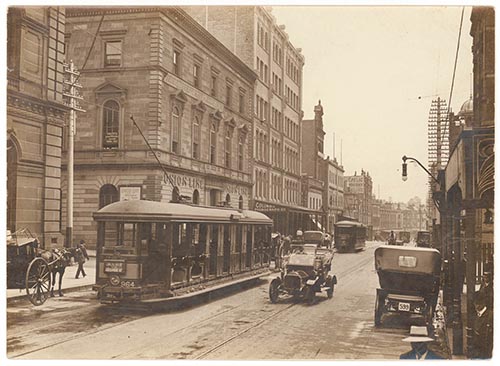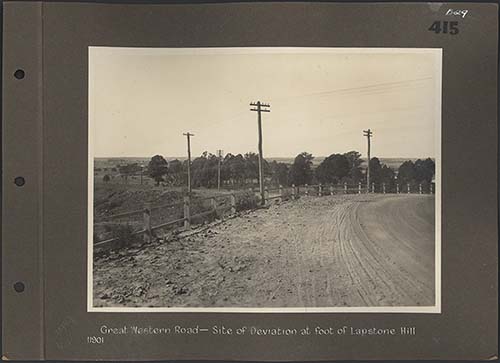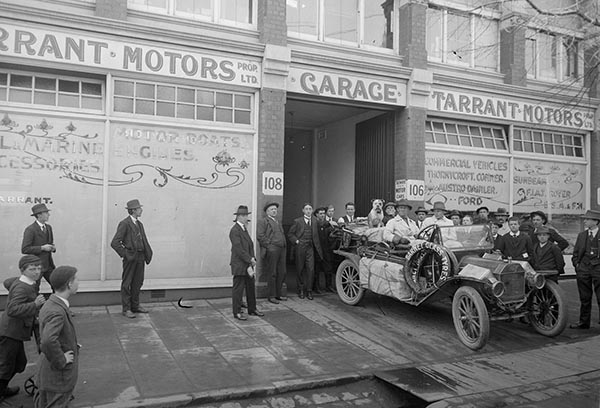|
When the Ford Model T made
its way to Australian shores in 1908, it wasn’t just
another invention crossing an ocean—it was the start of
a revolution on wheels. This unassuming, boxy machine
with its unmistakable chug brought more than just
horsepower to a horse-reliant land. It introduced
freedom. Independence. A taste of modernity. And most of
all, it carved out a brand-new class of car owners that
would reshape the Australian social landscape forever.
A Car
for the People
Until then, cars were the playthings of the
elite—expensive curiosities reserved for the wealthy,
who often didn’t even drive them themselves. If you were
rich enough to own a car, you were also rich enough to
hire a uniformed chauffeur to take the wheel. For the
average Australian, the idea of personal motor transport
was as distant as the moon.
But Henry Ford had a different vision: a car that was
simple, reliable, and above all, affordable. The Model T
delivered on every front. It was the product of a
manufacturing breakthrough—the assembly line—and this
mass production method slashed costs so dramatically
that owning a car was no longer a fantasy for ordinary
people.
Ford also had a clever trick up his sleeve for the
Australian market: knock-down kits. Instead of shipping
fully built cars halfway across the world, Ford sent the
parts to Australia to be assembled locally. This not
only sidestepped hefty import duties, but also reduced
production and labor costs. And just like that, the
Model T was cheaper to build, cheaper to buy—and
suddenly, attainable.
Model T comes to Australia
The Model T arrived in Australia
in 1908 as a knock-down kit and was assembled by local
dealers. It became affordable by a whole new class of
potential motorists who were far from wealthy including
farmers and tradesmen. The car quickly proved to be much
more convenient than a horse and buggy for doctors and
clergymen making house calls who didn’t have to worry
about catching, hitching, feeding, watering, shoeing,
housing, cleaning and generally looking after a horse.
It was comfortable, convenient and could travel much
more quickly than a buggy or coach.
Early
Australian Drivers
 It should be remembered that when
the Model T arrived people knew little about cars in
Australia at the time. It wasn’t unusual for them to
spend one or two days trying to start the new imported
car without realising that the tank needed petrol.
Others would spend years driving in one gear not knowing
how to, or realising they could, change gear. There were
few formed roads, no garages and petrol supplies. Petrol
was scarce and expensive and was purchased in tins from
a few chemists or grocers. Cars were often unreliable
and there were no mechanics so drivers had to repair
breakdowns. Handbooks and motoring advice columns had
articles on how to mend broken springs, bent axles and
broken steering columns. Motorists even had to carry a
comprehensive collection of nuts, bolts, wire and spare
tyres to ensure returning home at the end of a drive. It should be remembered that when
the Model T arrived people knew little about cars in
Australia at the time. It wasn’t unusual for them to
spend one or two days trying to start the new imported
car without realising that the tank needed petrol.
Others would spend years driving in one gear not knowing
how to, or realising they could, change gear. There were
few formed roads, no garages and petrol supplies. Petrol
was scarce and expensive and was purchased in tins from
a few chemists or grocers. Cars were often unreliable
and there were no mechanics so drivers had to repair
breakdowns. Handbooks and motoring advice columns had
articles on how to mend broken springs, bent axles and
broken steering columns. Motorists even had to carry a
comprehensive collection of nuts, bolts, wire and spare
tyres to ensure returning home at the end of a drive.
In 1909, institutions such as the Melbourne School of
Motoring opened to teach new owners to drive as very few
people knew how to drive their cars before they bought
them. Owners of the big expensive cars, the norm before
the Model T, often had their own uniformed chauffeurs.
However, it was the car salesman who taught the
purchaser of the Model T how to drive. Farmers were
apparently the worst pupils as they expected a car to
behave like a horse – to stay on a course when directed
and to steer automatically around any obstacles in its
path.
Early
Australian Roads
 Dust was an enormous problem for early Australian
motorists, especially until windscreens became standard
issue. Men wore goggles, caps, leather gloves and
motoring jackets while women required loose dustcoats of
tussore silk or other light materials and scarves or
veils worn over their faces to filter the air. The
modern wrist watch became acceptable for men to wear at
this time as it was too difficult to consult a pocket
watch while at the wheel. Hills were taken in first gear
and some, such as the old Lapstone Hill Road up the Blue
Mountains west of Sydney, was taken in reverse as this
gear was lower and the gravity fed petrol could reach
the carburettor. Dust was an enormous problem for early Australian
motorists, especially until windscreens became standard
issue. Men wore goggles, caps, leather gloves and
motoring jackets while women required loose dustcoats of
tussore silk or other light materials and scarves or
veils worn over their faces to filter the air. The
modern wrist watch became acceptable for men to wear at
this time as it was too difficult to consult a pocket
watch while at the wheel. Hills were taken in first gear
and some, such as the old Lapstone Hill Road up the Blue
Mountains west of Sydney, was taken in reverse as this
gear was lower and the gravity fed petrol could reach
the carburettor.
The Model T was to be ideal for Australian conditions.
The Australian motoring writer, Pedr Davis, said that it
was dubbed the ‘Squatter’s Joy’ because of its
popularity, especially with farmers. The simple,
lightweight design, which was criticised at first,
proved more rugged than its heavier more sophisticated
competitors and the 25 cm ground clearance, ability to
ride over stumps and being able to go through water made
it popular and useful on rough bush tracks. Weighing
only 760 kg, the car could be easily righted if it
overturned and was extremely economical to run for the
time. The car was so reliable and tough that it
accomplished a number of cross-country trips to prove
the car was a useful form of transport in outback
Australia.
A Nation
Behind the Wheel
The response from Australians was
electric. In no time, the Model T became the vehicle of
choice for clergymen doing their rounds, country doctors
rushing to remote homesteads, and farmers tired of
saddling up after a long day’s work. Families who once
squeezed into buggies behind tired horses were now
motoring down dusty country roads, marveling at the
strange new power under their feet.
What once symbolized luxury now became a tool for the
working class. The Model T didn’t just sell—it spread.
It was like wildfire on four wheels, and Australia, vast
and sparsely populated, was the perfect place for it to
thrive. In the eyes of many, it wasn’t a luxury
anymore—it was a necessity.
Francis Birtles
 One early cross-country journey was by the famous
overlander, Francis Birtles, whose 5,600 km journey down
Australia from the Gulf of Carpentaria to Port Phillip
Bay in 1913 was sponsored by Ford and achieved in a
Model T. Birtles was accompanied by his faithful friend,
Rex the “wonder dog”, who wore his own special pair of
dust goggles. Birtles had to dig the car out of numerous
bogs in the Gulf country and sandy creek crossings in
the centre. Camping along the way, he caught his own
bush tucker and used fuel left in special dumps for the
trip. The car was said to be in perfect condition on its
arrival in Melbourne and during the trip even won an
impromptu race against a British car, which had cost
1,000 pounds to buy. (At the time a Model T with a
touring car body only cost 210 pounds). One early cross-country journey was by the famous
overlander, Francis Birtles, whose 5,600 km journey down
Australia from the Gulf of Carpentaria to Port Phillip
Bay in 1913 was sponsored by Ford and achieved in a
Model T. Birtles was accompanied by his faithful friend,
Rex the “wonder dog”, who wore his own special pair of
dust goggles. Birtles had to dig the car out of numerous
bogs in the Gulf country and sandy creek crossings in
the centre. Camping along the way, he caught his own
bush tucker and used fuel left in special dumps for the
trip. The car was said to be in perfect condition on its
arrival in Melbourne and during the trip even won an
impromptu race against a British car, which had cost
1,000 pounds to buy. (At the time a Model T with a
touring car body only cost 210 pounds).
Advertising the Model T
A Ford advertisement in ‘The Land’ newspaper of 1914
showed how tempted the Australian public were by this
amazing little car:
Obey
that urge! Do it now! Get a Ford! It’s the one
“hunch” on which you can’t go wrong. More than
325,000 owners will vouch for FORD merit Ford
simplicity Ford serviceability and Ford economy.
Obey that urge! Do it now!
The advertising was obviously
working because in 1914 over 100 Fords were being sold
per month in NSW alone. The population of the state was
only 1.8 million at the time. The Model T was so good it
virtually sold itself and all advertising for the car
was suspended between 1917 and 1923 with the exception
of promotion by local dealers. To demonstrate just how
simple the Model T was to construct, Ford technicians
assembled a complete car in only 150 minutes during the
South Australian Agricultural Show of 1917, a display
watched by some 4,000 people. Stunts like these helped
to sell the car but it was its low price that was the
real attraction.
A Model T was many families’ first car and took car
ownership from the rich and privileged to the general
public. It was easy to maintain, simple, sturdy and
versatile, had interchangeable parts, and was virtually
unchanged throughout its long 19-year production run.
The car forced many competing manufacturers out of
business, including a number of fledgling Australian car
makers who could not compete with Ford’s low price. Some
dealers were assembling Model T’s better than others so
to standardise production, the Ford Motor Co. of
Australia was formed in 1925. Assembly of Model Ts was
established in a disused wool store in Geelong,
Victoria, using a type of production line system.
In all a total of 250,000 Model Ts were sold in
Australia and Ford assembly plants were subsequently
built and opened in Brisbane, Fremantle, and Adelaide.
Known affectionately as “Tin Lizzies”, Model Ts are one
of the few cars that over the years have been celebrated
in song, legend and folklore. In the words of Ford’s
advertising of the day, it was “truly the car for the
multitudes – The Universal Car”. In 2001 the Model T was
voted Car of the 21st Century by an international jury
of 126 automotive journalists from 32 countries.
The End of the Horse Era
For generations, Australians had
relied on horses for everything from transport to
agriculture. But horses were high maintenance. They
needed feeding, grooming, stabling, and rest. They
spooked easily and couldn’t cover long distances without
a break. By comparison, the Model T felt like something
out of science fiction. You didn’t have to brush it,
feed it, or coax it into moving. You turned the crank,
gave it petrol, and off you went.
Of course, it wasn’t all smooth sailing. The roads were
terrible—most were unsealed dirt tracks that turned into
sludge when it rained and dust storms when they dried.
Motorists had to dress for battle: men wore thick
leather gloves, goggles, dustcoats, and hats; women
wrapped themselves in scarves and donned long coats to
protect their clothing and lungs. It was an adventure
every time you left home.
Learning
Curve on the Move
As more Australians got behind the
wheel, a new problem emerged—nobody knew how to drive.
Before the Model T, driving was a specialist skill,
learned by chauffeurs and mechanics. Now, everyday
people were buying cars with zero training and heading
straight for the open road.
Crashes were common. So were breakdowns. Fuel was hard
to find in remote areas, and when the car coughed or
spluttered, there were few mechanics around who knew
what to do. Farmers, in particular, struggled. Many were
used to horses that instinctively avoided trees and
rocks. They expected their new "iron horse" to do the
same—and were sorely disappointed when it didn’t.
The demand for education grew quickly. By 1909, schools
like the Melbourne School of Motoring opened their
doors, teaching would-be drivers not just how to steer
and stop, but also how to change oil, patch tires, and
coax a cranky engine back to life.
The
Great Leveler
The arrival of the Model T didn’t
just transform transport—it reshaped society. It blurred
class lines, gave rural Australians newfound
independence, and helped bring distant communities
closer together. For the first time, people who lived
hours from a town could visit family, attend church, or
even deliver their produce to market—all in the same
day.
Cars were no longer a symbol of excess. They were a
symbol of progress. And at the heart of it all was the
humble Model T: a rattling, sputtering, dust-covered
machine that connected a continent.
|

